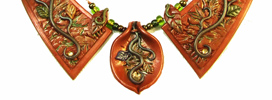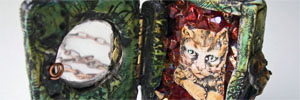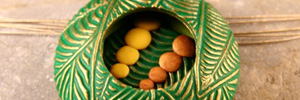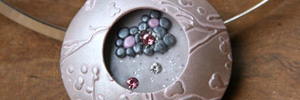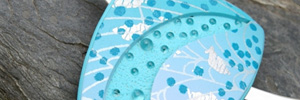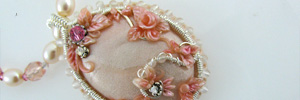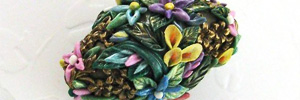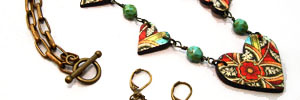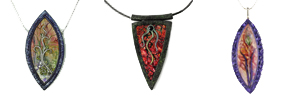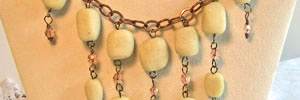
The following information is intended as a guide for the submission of materials to be considered for publication in The Polymer Arts magazine.
About The Polymer Arts magazine
The Polymer Arts was created to provide the polymer clay artist, as well as enthusiasts, collectors, and galleries, the kind of information that will encourage innovation and support of the art world’s youngest and most versatile medium. Even though in recent years accomplished and innovative polymer clay art work has been making its way into esteemed galleries and national museums, the general perception that polymer clay is an amateur or kid’s art material still persists. This industry specific periodical documents the high caliber of work and trends in the polymer community to not only support the artists but to engender serious consideration of polymer clay as a fine art form by the art world, university art programs, and the general public.
The Polymer Arts magazine is an English language quarterly available in both digital and print, making it readily accessible to artists and other supporters of polymer clay across the globe.
Guidelines for who can write for TPA
We welcome contributors who are polymer clay artists or work with polymer clay in association with other major mediums as well as art critics, historians, collectors, publicists and specialists who have a topic of interest to the polymer clay artist. For the purposes of journalistic integrity we do ask that authors of reviews or analytical articles have no personal connection or professional partnership with the subject matter they are writing on.
Types of Content Accepted
Content in TPA is 100% non-fiction that is either written from direct personal experience or is well researched with reference materials available upon request should it be applicable. A casual yet professional tone is preferred. Although we will consider any query that falls within the interest of the larger polymer clay community and items that address life as a working artist, the following list fulfills 95% of our content needs. First time writers should only query based on the following content:
· Feature Articles
Feature articles will directly reflect the theme of a particular issue. In general they will be editorial or researched articles that explore, in depth, a particular set of issues important to polymer artists or artists in general although direct correlation to polymer is expected. These are generally assigned/solicited rather than gained through the submission process. But please inquire if you have a specific feature idea that matches an upcoming there. (See the About section of the site for upcoming themes)
· Material Issues
These are in depth explorations of technical and creative polymer clay techniques and practices. Articles may come in the form of an editorial or researched article or a technique tutorial. Note that we don't usually publish project tutorials that simply show how to make one thing. Rather, we give them tutorials they teach them a skill that could be applied in various ways so readers can match it to the kind of work they do.
If submitting a technique tutorial it should be intermediate to advanced in skill level and include:
--A materials and tools list
--A short introduction about the author’s development, experimentation, or expansion of the technique.
--Step by step instructions that will allow a reader to follow along and reproduce the technique shown. Explanations of basic processes should be skipped--you should assume readers already know how to properly condition clay, complete a basic skinner blend, slice a cane, etc.
-- For the purpose of showing the application of the technique the steps usually include the development of a single project but at least two other examples of how the technique can be applied should be included for the article. The additional items do not need step-by-step instructions although brief steps or explanations can be added.
--A closing paragraph with ideas of uses for the technique, variations on the tutorial, and/or tips on successfully recreating the technique.
· The New and Improved
Testing and review of new products and tools or exploring new ways to use existing products. Tips and tricks for improving one’s studio space or artistic processes are also included in this section. These articles should consider the average user or explain how an item or ideas use would differ between different types of art work and/or artists.
· Artist Spotlight
Featuring one particularly accomplished artist. The article should be written in a conversational manner rather than Q&A but at least half of the piece should be the direct result of an artist interview. Submit an artist’s name and link to their work for consideration. Authors here may have a personal or professional connection to the artist if they can write honestly and without overtly indulging personal sentiment.
· Mentor, Accomplished and Emerging Artists' Galleries
Galleries of new and established artists' work with brief interviews. Candidates for these galleries can send links to their website, Flicker, Etsy or similar online source where the detail of the artwork can be readily seen and examined. Artists accepted into a gallery will be asked to provide 5-6 photos (see image guidelines) and complete a questionnaire or phone interview. Bios to accompany the photos in this section are generally written in house. There is no compensation for inclusion in the galleries but a website or other contact information will be included for interested parties to contact the artist through.
· The Bottom line
Articles on selling, displaying, listing, marketing, or any business related subject that affects the income of a working artist. Images may be produced or stock photos acquired where generalized or abstract ideas are being illustrated. If submitting such images to accompany the article, proof of the right to reproduce the images will be required.
· In Good Company
Personal experience & reporting on events, retreats, and workshops, new guilds or organizations, or formal art programs. This section is about the personal and professional contacts an artist makes and how the event or program, or ones similar to it, can help the working or inspiring artist build a business, gain inspiration, or find opportunities to expand the work they do with and about polymer clay.
· In The Studio
Focused on ways to work smarter, healthier, happier, and more efficiently in the space an artist spends so much time in. This section is about the personal and professional contacts an artist makes and how the event or program, or ones similar to it, can help the working or inspiring artist build a business, gain inspiration, or find opportunities to expand the work they do with and about polymer clay.
· Muse’s Corner
Personal style essay that speaks to experiences, community issues, inspiring stories or anything that might uplift or otherwise engage our primary market, the polymer artist. This is an open category but the author’s personal experience or connection to the subject matter should be apparent.
· Polymer Chat
Discussions of broad issues within the polymer community related to ethics, standards, public relations etc. .
Payment/Compensation
Contributors who write articles or even just submit a fully outlined technique which we then write up for clarity and/or produce photography for will be compensated monetarily or in trade for ad space or magazine copies if they prefer. The amount paid will be based on a collective number of factors that may include the contributor's expertise/recognition, scope/depth of the piece, writing quality, number and quality of photos included, etc. Most would be, roughly, in the range of .05-.10 cents a word plus consideration for photos on top of that but we will assess each submission individually. Inclusion in the Galleries or contributing an image or two to an article is rewarded through exposure and promotion on those pages and a digital copy of that issue. Payment is made within 30 days of publication. We do not offer kill fees.
Copyright
We do usually ask for exclusive copyright of 6 months-1 year on text (but not usually on photos) then non-exclusive, all media worldwide rights for both text & photos following the exclusive copyright period with the right to publish it in both print and digital versions as well as including the text in whole or in part for any future publication type, including but not limited to online services, reprints, or books which means the contributor has the right to reprint or sell the article without limiting our rights to reprint as well. In some instances, where we or a contracted writer we pay must heavily re-write or edit a piece, we may ask for full copyright ownership of the text.
We will not ask for exclusive photo rights unless it is work-for-hire from the start. A photographic release form will be sent to be signed and returned before article publication. Submission in a non-compensated section such as the Inspiration Gallery or Reader's Round Robin is done so with an understanding that permission is given with the submission.
Submission Process
Article queries are required first
Queries save both you and us time and unnecessary work. Before spending time and energy writing an article with TPA in mind, you can find out if your chosen subject is something we are presently looking for, increasing your chances of having an article accepted. Sometimes the core subject is of interest but not the approach in which case, the query gives us the chance to respond with alternate ideas to create an article that would fit the upcoming editorials goals.
What to include in a query
· Explanation of subject matter. Include a summary explanation of the content, proposed research sources (if applicable), and why you believe readers would be interested.
· Proposed images--include an attachment or link to image examples
· Your qualifications and/or interest in this particular subject.
· The query should be short and succinct and just list the bare bones.
If we invite you to submit an article based on a query, that is an invitation but not a guarantee of acceptance. Timely submission, writing quality, picture quality, and editorial considerations all play a part in what is eventually accepted. Keep in mind, we know most of our potential contributors are more adept as making art than writing or photographing and we are willing to work with you to get the material to the level we would like to see.
Queries of interest will be responded to within 3 months. We will try to respond to all queries even those we do not have an interest in, but if we do not, please understand it is not always possible and after 3 months, you should consider that particular query excluded from consideration. We do hope you'll continue to submit ideas regardless.
Article Submission
If you are invited to contribute, an email address to which the completed article can be submitted and specifications for the document and any images accompanying it will be sent to you. We only accept digital submissions in .doc, .docx, .txt or .rtf formats. Further details will be sent with the invitation to contribute.
Article Acceptance
If we accept your article, a writer’s agreement with compensation and any stipulations will be sent to you to sign and return. Payment is offered on a per project basis and is determined based on the type of article, need for original images, length, author’s skill level, etc.
Submitting Images
We only accept clear, high quality images that show appropriate and sufficient lighting, proper color, and contrast as needed. All images must be in focus, have the appropriate depth of field and no part of the primary image should be underexposed or in shadow unless it is for obvious artistic intent.
For artwork backgrounds should be uncluttered and without heavy patterning or stark texture. Use neutral colors and, as a general rule, avoid white unless you are highly experienced with adjusting white balance appropriately. Blacks, grays, low saturation color, and earth tones do well for backgrounds. If you are not an experienced photographer with proper equipment we strongly suggest you employ a professional.
We encourage the submission of more than the required photos in order to ensure we have sufficient options to choose from for the best presentation and to accommodate different layout options.
Image Format
Professional-quality digital images are expected. We can help with recommendations for improving shots. Send sample images once an aritcle is accepted and we'll assist. Unless you have experience and the capability to convert images and prepare them for print, we will ask that you send the original image file that was saved directly from the camera (or as close to that as possible).
Images sizes
General article images: Minimum print size of 3"/75mm at 300 dpi (900x900 pixels minimum)
Cover candidates: Minimum 8"/200mm at 300 dpi on the short side (2400x2400 pixels minimum)
Headshots (for author bio): 1"/25mm head size (300 pixels minimum)
To find out the resolution/pixel dimension of an image:
· Place your cursor over the image file in the folder you have it in
· If you are using a PC, right-click if a Mac then Ctrl-click.
· Scroll down to 'Properties'.
· Select the 'Details' tab.
· Scroll down to the Image section - To view the image dimensions.
Acceptable file types
· High Resolution PDF’s (PDF/X-1a compliant)
· JPG/JPEG
· TIFF or RAW
· No gifs or pngs
· Illustrations accepted in Illustrator, InDesign, Photoshop or .eps
Specs
· Must be 300 dpi or higher at 5” or more on the short side
· CMYK
· Black and White images must be in gray scale or bit-mapped formats
Sending Images
Images under 10MB in size can be emailed but should be zipped. Larger files should be zipped and uploaded through a file-transfer site such as www.WeTransfer.com
About The Polymer Arts magazine
The Polymer Arts was created to provide the polymer clay artist, as well as enthusiasts, collectors, and galleries, the kind of information that will encourage innovation and support of the art world’s youngest and most versatile medium. Even though in recent years accomplished and innovative polymer clay art work has been making its way into esteemed galleries and national museums, the general perception that polymer clay is an amateur or kid’s art material still persists. This industry specific periodical documents the high caliber of work and trends in the polymer community to not only support the artists but to engender serious consideration of polymer clay as a fine art form by the art world, university art programs, and the general public.
The Polymer Arts magazine is an English language quarterly available in both digital and print, making it readily accessible to artists and other supporters of polymer clay across the globe.
Guidelines for who can write for TPA
We welcome contributors who are polymer clay artists or work with polymer clay in association with other major mediums as well as art critics, historians, collectors, publicists and specialists who have a topic of interest to the polymer clay artist. For the purposes of journalistic integrity we do ask that authors of reviews or analytical articles have no personal connection or professional partnership with the subject matter they are writing on.
Types of Content Accepted
Content in TPA is 100% non-fiction that is either written from direct personal experience or is well researched with reference materials available upon request should it be applicable. A casual yet professional tone is preferred. Although we will consider any query that falls within the interest of the larger polymer clay community and items that address life as a working artist, the following list fulfills 95% of our content needs. First time writers should only query based on the following content:
· Feature Articles
Feature articles will directly reflect the theme of a particular issue. In general they will be editorial or researched articles that explore, in depth, a particular set of issues important to polymer artists or artists in general although direct correlation to polymer is expected. These are generally assigned/solicited rather than gained through the submission process. But please inquire if you have a specific feature idea that matches an upcoming there. (See the About section of the site for upcoming themes)
· Material Issues
These are in depth explorations of technical and creative polymer clay techniques and practices. Articles may come in the form of an editorial or researched article or a technique tutorial. Note that we don't usually publish project tutorials that simply show how to make one thing. Rather, we give them tutorials they teach them a skill that could be applied in various ways so readers can match it to the kind of work they do.
If submitting a technique tutorial it should be intermediate to advanced in skill level and include:
--A materials and tools list
--A short introduction about the author’s development, experimentation, or expansion of the technique.
--Step by step instructions that will allow a reader to follow along and reproduce the technique shown. Explanations of basic processes should be skipped--you should assume readers already know how to properly condition clay, complete a basic skinner blend, slice a cane, etc.
-- For the purpose of showing the application of the technique the steps usually include the development of a single project but at least two other examples of how the technique can be applied should be included for the article. The additional items do not need step-by-step instructions although brief steps or explanations can be added.
--A closing paragraph with ideas of uses for the technique, variations on the tutorial, and/or tips on successfully recreating the technique.
· The New and Improved
Testing and review of new products and tools or exploring new ways to use existing products. Tips and tricks for improving one’s studio space or artistic processes are also included in this section. These articles should consider the average user or explain how an item or ideas use would differ between different types of art work and/or artists.
· Artist Spotlight
Featuring one particularly accomplished artist. The article should be written in a conversational manner rather than Q&A but at least half of the piece should be the direct result of an artist interview. Submit an artist’s name and link to their work for consideration. Authors here may have a personal or professional connection to the artist if they can write honestly and without overtly indulging personal sentiment.
· Mentor, Accomplished and Emerging Artists' Galleries
Galleries of new and established artists' work with brief interviews. Candidates for these galleries can send links to their website, Flicker, Etsy or similar online source where the detail of the artwork can be readily seen and examined. Artists accepted into a gallery will be asked to provide 5-6 photos (see image guidelines) and complete a questionnaire or phone interview. Bios to accompany the photos in this section are generally written in house. There is no compensation for inclusion in the galleries but a website or other contact information will be included for interested parties to contact the artist through.
· The Bottom line
Articles on selling, displaying, listing, marketing, or any business related subject that affects the income of a working artist. Images may be produced or stock photos acquired where generalized or abstract ideas are being illustrated. If submitting such images to accompany the article, proof of the right to reproduce the images will be required.
· In Good Company
Personal experience & reporting on events, retreats, and workshops, new guilds or organizations, or formal art programs. This section is about the personal and professional contacts an artist makes and how the event or program, or ones similar to it, can help the working or inspiring artist build a business, gain inspiration, or find opportunities to expand the work they do with and about polymer clay.
· In The Studio
Focused on ways to work smarter, healthier, happier, and more efficiently in the space an artist spends so much time in. This section is about the personal and professional contacts an artist makes and how the event or program, or ones similar to it, can help the working or inspiring artist build a business, gain inspiration, or find opportunities to expand the work they do with and about polymer clay.
· Muse’s Corner
Personal style essay that speaks to experiences, community issues, inspiring stories or anything that might uplift or otherwise engage our primary market, the polymer artist. This is an open category but the author’s personal experience or connection to the subject matter should be apparent.
· Polymer Chat
Discussions of broad issues within the polymer community related to ethics, standards, public relations etc. .
Payment/Compensation
Contributors who write articles or even just submit a fully outlined technique which we then write up for clarity and/or produce photography for will be compensated monetarily or in trade for ad space or magazine copies if they prefer. The amount paid will be based on a collective number of factors that may include the contributor's expertise/recognition, scope/depth of the piece, writing quality, number and quality of photos included, etc. Most would be, roughly, in the range of .05-.10 cents a word plus consideration for photos on top of that but we will assess each submission individually. Inclusion in the Galleries or contributing an image or two to an article is rewarded through exposure and promotion on those pages and a digital copy of that issue. Payment is made within 30 days of publication. We do not offer kill fees.
Copyright
We do usually ask for exclusive copyright of 6 months-1 year on text (but not usually on photos) then non-exclusive, all media worldwide rights for both text & photos following the exclusive copyright period with the right to publish it in both print and digital versions as well as including the text in whole or in part for any future publication type, including but not limited to online services, reprints, or books which means the contributor has the right to reprint or sell the article without limiting our rights to reprint as well. In some instances, where we or a contracted writer we pay must heavily re-write or edit a piece, we may ask for full copyright ownership of the text.
We will not ask for exclusive photo rights unless it is work-for-hire from the start. A photographic release form will be sent to be signed and returned before article publication. Submission in a non-compensated section such as the Inspiration Gallery or Reader's Round Robin is done so with an understanding that permission is given with the submission.
Submission Process
Article queries are required first
Queries save both you and us time and unnecessary work. Before spending time and energy writing an article with TPA in mind, you can find out if your chosen subject is something we are presently looking for, increasing your chances of having an article accepted. Sometimes the core subject is of interest but not the approach in which case, the query gives us the chance to respond with alternate ideas to create an article that would fit the upcoming editorials goals.
What to include in a query
· Explanation of subject matter. Include a summary explanation of the content, proposed research sources (if applicable), and why you believe readers would be interested.
· Proposed images--include an attachment or link to image examples
· Your qualifications and/or interest in this particular subject.
· The query should be short and succinct and just list the bare bones.
If we invite you to submit an article based on a query, that is an invitation but not a guarantee of acceptance. Timely submission, writing quality, picture quality, and editorial considerations all play a part in what is eventually accepted. Keep in mind, we know most of our potential contributors are more adept as making art than writing or photographing and we are willing to work with you to get the material to the level we would like to see.
Queries of interest will be responded to within 3 months. We will try to respond to all queries even those we do not have an interest in, but if we do not, please understand it is not always possible and after 3 months, you should consider that particular query excluded from consideration. We do hope you'll continue to submit ideas regardless.
Article Submission
If you are invited to contribute, an email address to which the completed article can be submitted and specifications for the document and any images accompanying it will be sent to you. We only accept digital submissions in .doc, .docx, .txt or .rtf formats. Further details will be sent with the invitation to contribute.
Article Acceptance
If we accept your article, a writer’s agreement with compensation and any stipulations will be sent to you to sign and return. Payment is offered on a per project basis and is determined based on the type of article, need for original images, length, author’s skill level, etc.
Submitting Images
We only accept clear, high quality images that show appropriate and sufficient lighting, proper color, and contrast as needed. All images must be in focus, have the appropriate depth of field and no part of the primary image should be underexposed or in shadow unless it is for obvious artistic intent.
For artwork backgrounds should be uncluttered and without heavy patterning or stark texture. Use neutral colors and, as a general rule, avoid white unless you are highly experienced with adjusting white balance appropriately. Blacks, grays, low saturation color, and earth tones do well for backgrounds. If you are not an experienced photographer with proper equipment we strongly suggest you employ a professional.
We encourage the submission of more than the required photos in order to ensure we have sufficient options to choose from for the best presentation and to accommodate different layout options.
Image Format
Professional-quality digital images are expected. We can help with recommendations for improving shots. Send sample images once an aritcle is accepted and we'll assist. Unless you have experience and the capability to convert images and prepare them for print, we will ask that you send the original image file that was saved directly from the camera (or as close to that as possible).
Images sizes
General article images: Minimum print size of 3"/75mm at 300 dpi (900x900 pixels minimum)
Cover candidates: Minimum 8"/200mm at 300 dpi on the short side (2400x2400 pixels minimum)
Headshots (for author bio): 1"/25mm head size (300 pixels minimum)
To find out the resolution/pixel dimension of an image:
· Place your cursor over the image file in the folder you have it in
· If you are using a PC, right-click if a Mac then Ctrl-click.
· Scroll down to 'Properties'.
· Select the 'Details' tab.
· Scroll down to the Image section - To view the image dimensions.
Acceptable file types
· High Resolution PDF’s (PDF/X-1a compliant)
· JPG/JPEG
· TIFF or RAW
· No gifs or pngs
· Illustrations accepted in Illustrator, InDesign, Photoshop or .eps
Specs
· Must be 300 dpi or higher at 5” or more on the short side
· CMYK
· Black and White images must be in gray scale or bit-mapped formats
Sending Images
Images under 10MB in size can be emailed but should be zipped. Larger files should be zipped and uploaded through a file-transfer site such as www.WeTransfer.com
CONTRIBUTOR’S GUIDELINES--
Copyright © 2011-2017 by Tenth Muse LLC • All Rights reserved

